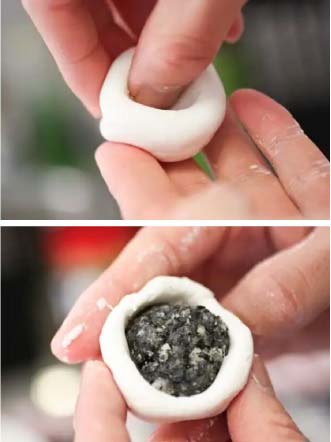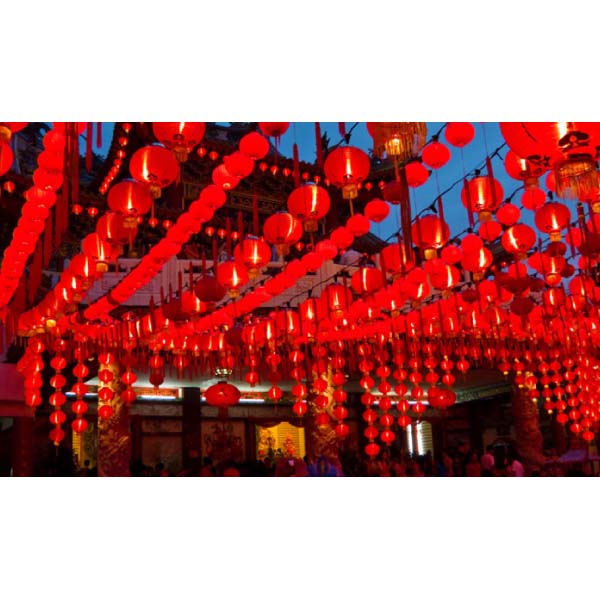
The Lantern Festival (元宵節) is celebrated on the 15th day of the first lunar month, and signals the end of the Chinese New Year Spring Festival (春節). Also known as Shangyuan Festival (上元節), this event marks the first full moon of the year, which falls on February 19 this year.
The Lantern Festival can be traced back to 2,000 years ago. During the Eastern Han Dynasty (25-220 AD), Emperor Han Ming Di (漢明帝), a Buddhist advocate, learned that monks lit lanterns in the temples on the 15th day of the first lunar month to show respect to Buddha. He thus ordered all temples, royal palaces and households to light lanterns to follow this practice.
During the festival, people eat yuanxiao (元宵 dumpling ball), a Chinese dessert made from glutinous rice flour mixed with a small amount of water to form into balls. The stickiness of the rice ball represents family togetherness, happiness and auspiciousness.
Another version of the story about the origin of the Lantern Festival and eating yuanxiao: During the reign of Emperor Han Wu Di (漢武帝), there was a pretty, clever palace maid by the name of Yuanxiao. She was terribly homesick from being confined in the palace.
She fashioned a clever story to give her an opportunity to see her parents. The minister, Dongfang Shuo, was sympathetic to Yuanxiao’s plight and helped relay her story to the emperor.
The minister told the emperor that the Supreme Diety of Heaven has ordered the God of Fire to set the capital city of Chang’an on fire on the 16th day of the first lunar month. As the Supreme Diety enjoys watching burning scenes, the only way to appease the diety and prevent him from pursuing the plan is to set off firecrackers and hang up red lanterns all over the city the night before. The emperor, consorts, palace maids and households should all go out for the lantern show. In addition, the God of Fire loves to eat stuffed dumplings made by the palace maid Yuanxiao so these should be presented as offerings.
The emperor, upon hearing the story, ordered this to be carried out and nothing amiss happened the next day. Yuanxiao then took advantage of the opportunity to have a family reunion.
Since that time, the emperor ordered that these be practiced every year on the same date, which became known as Lantern Festival or Yuanxiao Festival. And the sweet dumpling was also called yuanxiao.
Yuanxiao was later changed to tangyuan (湯圓). According to one version, the warlord Yuan Shikai (袁世凱 1912-1916) disliked the name yuanxiao because it sounded identical to “remove Yuan (袁消),” and ordered the name changed to tangyuan, which means round balls in soup.
Tangyuan is also known as Shangyuan ball (上元丸 Siong Guan Ee in Hokkien). Others refer to it as Zhuangyuan ball (壯元丸 Tsiong Guan Ee in Hokkien).
Tangyuan can be filled or unfilled. Possible fillings can be sesame, peanuts, sweet bean paste or a mix of all.

In the Philippines, Shangyuan ball is better known as peanut ball because it has sweetened crushed peanut fillings. The peanut balls are boiled in water with ginger and rock sugar, some add mandarin peels to enhance the flavor.
Other variations of fillings are fruit preservatives, sugarcane rock candy, chocolate paste, red bean paste, sesame paste, chopped peanuts or even peanut butter.
Traditionally in China, aside from eating tangyuan, people send flying lanterns to the sky, enjoy the sight of the moon, solve riddles written on the lanterns and enjoy the performances of dragon and lion dances.
In the Philippines, there are lantern shows organized by Tsinoy organizations every year. Previous years’ venues were the Chinese Garden in Luneta and Liwasang Bonifacio.
Some elderly Tsinoys still prepare unfilled tangyuan, called bilo-bilo, at home but most would buy peanut balls which are readily available in Binondo and Chinese delicacy stores in other cities.
Ginataang bilo-bilo is served in coconut milk with saba, tapioca, langka and sweet potatoes.
Another traditional belief linked with tangyuan is age: Parents would tell their growing children, “After eating tangyuan, gain one year (吃了湯圓大一歳).”
While westerners count their age by actual birthdays, the Chinese add one year to their age upon the turn of a new year. Eating tangyuan thus symbolizes the adding of one year to one’s age.
Traditionally, tangyuan is colored white. But with changing tastes, coupled with the effort to make tangyuan more visually enticing, new flavors and colors of tangyuan are created and traditional fillings are substituted with mashed potato, pumpkin paste, chocolate or creamy custard. We can even create our own local inspired tangyuan by trying ube, pandan or even keso flavored ones.
And although tangyuan is associated with the Winter Solstice and Chinese New Year, it is now served year-round as dessert in restaurants.
So, enjoy the first full moon in the Year of the Pig this Feb. 19 while eating your peanut ball soup, but be mindful of sugar rush from too much peanut balls.
Recipe for Tangyuan

Ingredients:
1 cup black sesame seeds/roasted peanuts
¼ cup sugar
¼ teaspoon salt
¼ cup lard or butter, vegetarians may use coconut oil
4 cups glutinous rice flour
Making fillings:
- Roast black sesame in a pan over a low heat until aromatic and grind black sesame/peanuts using blender or food processor until oily.
- Mix in a bowl with salt and sugar. Pour butter/lard, mix and blend well until smooth. Place in refrigerator for 30 minutes to an hour until slightly hardened.
- Shape the fillings into 1-inch diameter balls.
Making dough: Place glutinous rice flour in a bowl, add 1 cup boiling water in the center and wait for 10 minutes, then pour 1½ cups cold water and stir to form a dough. Knead the dough until smooth. Cut dough into small pieces and roll into 1½-inch diameter balls.
Making tangyuan: Take one dough ball and press to form a hollow at the center. Add fillings in the hallowed center and seal it by rolling in your hands to form a ball.
Cooking:
- Boil water in a pot. Water should be at least 1 inch higher than the ball. Add the ball and stir in one direction to prevent from sticking. Continue cooking for 1 to 2 minutes after they float to the surface.
- Ginger, mandarin peel may be added while cooking for flavoring.
Another way of cooking tangyuan is to deep-fry them. Filled tangyuan are fried in hot oil until surface is crispy.





